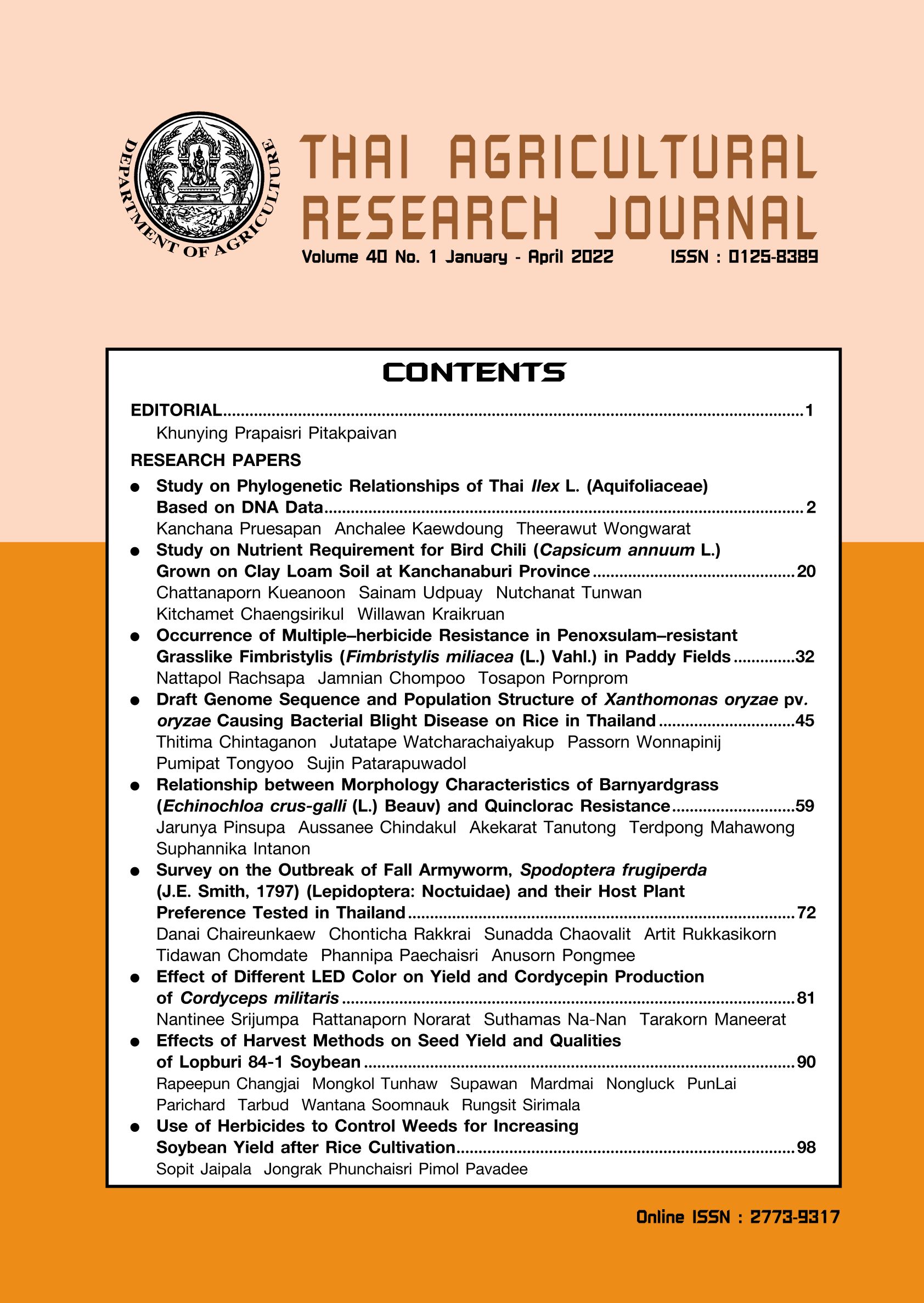Occurrence of Multiple–herbicide Resistance in Penoxsulam–resistant Grasslike Fimbristylis (Fimbristylis miliacea (L.) Vahl.) in Paddy Fields
DOI:
https://doi.org/10.14456/thaidoa-agres.2022.3Keywords:
Fimbristylis miliacea (L.) Vahl., Cross-Resistance, Multiple-Resistance, ALS-Inhibitors, PenoxsulamAbstract
Grasslike fimbristylis is a common weed of paddy fields, which is most often controlled by penoxsulam, acetolactate synthase (ALS) inhibitors. After several years of successful control there were recent failure reports by farmers in Krachan Sub-district, U-Thong District, Suphan Buri Province, This study was conducted to determine whether grasslike fimbristylis populations have developed resistance to penoxsulam in paddy fields. Weed seeds were collected from farmer’s fields to determine the physiological response to penoxsulam. The experiment was designed as a split-plot design in CRD with four replications. The main plots consisted of six penoxsulam dose rates (0, 7.03, 14.06, 28.12, 56.24 and 112.48 g a.i./ha) while sub-plots were comprised of grasslike fimbristylis of susceptible and resistant biotypes. The experimental plots were treated with herbicides 15 days after seed sowing. Reaction of both resistant and susceptible biotypes to penoxulam were assessed for resistance index, I 50 based on visual injury and GR50 based on plant height and fresh weight at 5, 10, 14 and 21 days after application. The resistance index to penoxulam of resistant biotype was approximately 27-66 times higher than that of the susceptible biotype. The cross-herbicide resistance of penoxsulam-resistant biotype to the other ALS-inhibiting herbicides with the same site of action was determined. Results indicated that penoxsulam-resistant grasslike fimbristylis was not controlled at the labelled rate by bispyribac-sodium, pyribenzoxim and pyrazosulfuron-ethyl. In addition, the multiple herbicide resistance of penoxsulam-resistant biotype was subjected to treatments by other herbicides with different modes of action. Results indicated that alternative herbicides which could be used to control penoxsulam resistant grasslike fimbristylis were carfentrazone-ethyl (Contacts-membrane disrupters) and propanil (Inhibitors of photosynthesis at PS II) at the recommended rate of each herbicide. The results also suggested that farmers should rotate the application of carfentrazone-ethyl and propanil, which have different herbicide sites of action, to control and reduce the probability of penoxsulam-resistant grasslike fimbristylis occurrence in paddy fields.
References
วัชรา มณฑาทิพย์ จำเนียร ชมภู และทศพล พรพรหม. 2560. หญ้าแดง (Ischaemum rugosum Salisb.) ต้านทานต่อสารบีสไพริแบค-โซเดียมในข้าวนาหว่านนำ้ตม. น. 933-946. ใน.การประชุมวิชาการอารักขาพืชแห่งชาติ ครั้งที่ 13, 21-23 พฤศจิกายน 2560, ตรัง.
สุตานันท์ โพธิ์สวัสดิ์ สุรพล ฉินทกานันท์ จำเนียร ชมภู และทศพล พรพรหม. 2558. การศึกษาหญ้า ข้าวนกต้านทานสารบีสไพรีแบค-โซเดียมในนา หว่านน้ำตม. น. 541-550. ใน: การประชุมวิชาการอารักขาพืชแห่งชาติ ครั้งที่ 12, 20-22 พฤศจิกายน 2558, เชียงราย.
Begum, M., A.S. Juraimi, S.R. Syed Omar, A. Rajan and M. Azmi. 2008. Effect of Herbicides for the Control of Fimbristylis miliacea (L.) Vahl. in Rice. J. Agronomy. 7(3): 251-257.
Burrill, L.C., J. Cardienas and E. Locatelli. 1976. Field Manual for Weed Control Research. International Plant Protection Center, Oregon State University, Corvallis. 630 p.
Caton, B.P., M. Mortimer, J.E. Hill and D.E. Johnson. 2010. A Practical Field Guide to Weed of Rice in Asia. 2nd Ed. International Rice Research Institute. Los Banos, Laguna, Philippines. 118 p.
Chen, J., Q. Yu, M. Owen, H. Hanand S. Powles.2017. Dinitroaniline herbicide resistance in a multiple-resistant Lolium rigidum population. Pest Manag. Sci. 74(4): 925-932.
R Core Team. 2020. A language and environment for statistical computing. R Foundationfor Statistical Computing, Vienna, Austria. ISBN 3-900051-07-0. Available at : http://www.R r-project.org. Accessed: February 18, 2021.
Heap, I. 2022. International survey of herbicide resistant weeds. Available at: http://www. weedscience.org. Accessed: January 02, 2022.
Jiapeng, F., Y. Zhang, T. Liu, B. Yan, J. Li and L. Dong. 2019. Target-site and metabolic resistance mechanisms to penoxsulam in barnyardgrass (Echinochloa crus-galli (L.) P. Beauv). J. Agric. Food Chem. 67(29): 8085–8095.
Maneechote, C., S. Samanwong, X.Q. Zhang and S.B. Powles. 2005. Resistance to A Case inhibiting herbicides in population of sprangletop(Leptochloa chinensisL. Nees). Weed Sci. 53(3): 290-295.
Peng, Q., H. Heping, Y. Xia, B. Lianyang, Y. Qin and S.B. Powles. 2019. Quinclorac resistance in Echinochloa crus-galli from China. Rice Sci. 26(5): 300-308.
Phinyosak, R . and T . Pornprom. 2017. Resistance of Fimbristylis miliacea (L.) Vahl populations to acetolactate synthase inhibiting herbicides. pp.95. In: The 26th Asian-Pacific Weed Science Society Conference.19-22 September 2017, Kyoto, Japan.
Pornprom,T., P. Mahatamnuchoke and K. Usui. 2006. The role of alteredacetyl-CoA carboxylasein conferring resistance to fenoxaprop-P ethyl in Chinese sprangletop (Leptochloa chinensis L. Nees). Pest Manag. Sci. 62(11): 1109-1115.
Sakuma, M. 1998. Probit analysis of preference data. Applied Entomology and Zoology. 33(3): 339–347.
Schaedler, C.E., J.A. Noldin, D.S. Eberhardt, D. Agostinetto and N.R. Burgos. 2013. Globe fringerush (Fimbristylis miliacea) cross resistance to ALS-inhibitor herbicides under field conditions in irrigated rice in the south of Brazil. Planta Daninha. 31(4): 893-902.
Valverde, B.E., C.R. Riches and J.C. Caseley. 2000. Prevention and Management of Herbicide Resistant Weeds in Rice: Experiences from Central America with Echinochloa colona. Camara de Insumos Agropecuarios de Costa Rica, Jan Jose. Available at: http:// www.weedscience.org/Bernal/RiceRW.html. Accessed: January 1, 2022.
Zakaria, N., M.S. Ahmad-Hamdaniand A.S. Juraimi. 2018. Patterns of resistance to AHAS inhibitors in Limnocharis flava from Malaysia. Plant Prot. Sci. 54(1): 48–59
Downloads
Published
How to Cite
Issue
Section
License
Copyright (c) 2022 Thai Agricultural Research Journal

This work is licensed under a Creative Commons Attribution-NonCommercial-NoDerivatives 4.0 International License.
Thai Agricultural Research Journal



